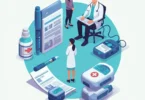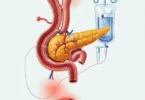Type 1 Diabetes
The type 1 diabetes is a disorder of sugar metabolism, which is due to a malfunction of the pancreas. The body’s own antibodies (auto-antibodies) destroying their own insulin producing cells in the pancreas so too little or no insulin is formed. People with type 1 diabetes must inject insulin for life, in order to reduce their blood sugar levels. Here you can read all about diabetes type 1.
Type 1 diabetes usually occurs in the childhood, adolescence and early adulthood. Therefore, this form of diabetes was formerly often referred to as juvenile diabetes. A type 1 diabetes can also develop in an infant or later in adulthood.
The insulin play central role in blood sugar regulation, which is produced in the pancreas by beta cells. In type 1 diabetes, the insulin-producing cells are damaged by the body’s immune system and so it is no longer made enough insulin. Due to damage of beta cells, level of insulin is reducing in blood. As a result sugar cannot transport from blood into body cells which causes increase in sugar level of blood.
Type 1 diabetes occurs significantly less as compared to Only about five percent of diabetes mellitus diseases are associated with type 1 diabetes. The disease can occur at any age, but chances of occurrence is more in younger. According to some researchers, the incidence of type 1 diabetes mellitus is increasing throughout the world by 2-5%. The reasons for this are unknown. Approximately 10% percent adults have type 1 diabetes and 90 percent have type 2 diabetes worldwide. And approximately 96% children have Type 1 diabetes and 3-4% children have Type 2 diabetes.
Type 5 countries with highest percentage of affected persons are:
- China
- India
- United State
- Russia
- Brazil
Causes Of Type 1 Diabetes
Causes of type 1 diabetes are not known completely. Type 1 diabetes is polygenic disease which is caused by 20 different genes. some environmental factors are also involved.
Symptoms of Type 1 Diabetes
Type 1 Diabetes is always noticeable with typical symptoms like acetone like smell in breath, frequent urination, weight loss, thirst, fatigue, dry skin etc.
Consequences
If blood glucose levels are significantly increased over the years, this can lead to serious and irreversible health consequences. Sequelae and damages due to insufficiently treated diabetes (poorly controlled Diabetes) can affect many organs. It comes to damage to the small blood vessels that supply blood to the tissues.
Therefore, with passage of time they effect finest vessels, for example badly damaged vessels in retina that causes blindness (diabetic retinopathy) or damage the nephrones in the kidneys causes kidney failure (diabetic nephropathy). This also leads to damage the nerves. The sense of touch, temperature perception and pain perception are then compromised. As a result, for example, sores can develop because the victims do not notice bruises and minor injuries. Than these wounds heal are very poor due to restricted blood flow to body tissues.
That’s way diagnosis and treatments of diabetes is very necessary
Treatments of Type 1 diabetes
Type 1 diabetes patient use insulin through out his life because type 1 diabetes is result from absolute deficiency of insulin. Nutrition and diet have significant effect on disease. Conventional insulin therapy and are commonly used depending on states of disease.
Click here for more information Treatments of Type 1 Diabetes






